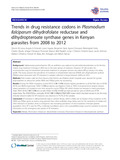| dc.contributor.author | Juma, DW | |
| dc.contributor.author | Omondi, AA | |
| dc.contributor.author | Ingasia, L | |
| dc.contributor.author | Opot, B | |
| dc.contributor.author | Cheruiyot, A | |
| dc.contributor.author | Yeda, R | |
| dc.contributor.author | Okudo, C | |
| dc.contributor.author | Muiruri, P | |
| dc.contributor.author | Ngalah, B | |
| dc.contributor.author | Chebon, LJ | |
| dc.contributor.author | Eyase, F | |
| dc.contributor.author | Johnson, J | |
| dc.contributor.author | Bulimo, WD | |
| dc.contributor.author | Akala, HM | |
| dc.contributor.author | Andagalu, B | |
| dc.contributor.author | Kamau, E | |
| dc.date.accessioned | 2014-12-11T09:24:11Z | |
| dc.date.available | 2014-12-11T09:24:11Z | |
| dc.date.issued | 2014 | |
| dc.identifier.citation | Juma DW, Omondi AA, Ingasia L, Opot B, Cheruiyot A, Yeda R, Okudo C, Cheruiyot J, Muiruri P, Ngalah B, Chebon LJ, Eyase F, Johnson J, Bulimo WD, Akala HM, Andagalu B, Kamau E. "Trends in drug resistance codons in Plasmodium falciparum dihydrofolate reductase and dihydropteroate synthase genes in Kenyan parasites from 2008 to 2012." Malar. J.. 2014;13:250. | en_US |
| dc.identifier.uri | http://hdl.handle.net/11295/77293 | |
| dc.description.abstract | Background: Sulphadoxine-pyrimethamine (SP), an antifolate, was r eplaced by artemether-lumefantrine as the first-line malaria drug treatment in Kenya in 2004 due to the wide s pread of resistance. However, SP still remains the recommended drug for intermittent preventive treatment in pregnant women and infants (IPTP/I) owing to its safety
profile. This study assessed the prevalence of mutations in dihydrofolate reductase(Pfdhfr )anddihydropteroate synthase(Pfdhps) genes associated with SP resistance in samples collected in Kenya between 2008 and 2012.Methods:Field isolates collected from Kisumu,Kisii, Kericho and Malindi district hospitals were assessed for genetic
polymorphism at various loci within Pfdhfr and Pfdhpsgenes by sequencing. Results:Among the Pfdhfr mutations, codons N51I,C59R,S108N showed highest prevalence in all the field sites at 95.5%, 84.1% and 98.6% respectively. Pfdhfr S108N prevalence was highest in Kisii at 100 %. A temporal trend analysis showed steady prevalence of mutations over time except for codon Pfdhps 581 which showed an increase in mixed genotypes.Triple Pfdhfr N51I/C59R/S108N and double PfdhpsA437G/K540E had high prevalence rates of 86.6% and 87.9% respectively. The Pfdhfr/Pfdhps quintuple, N51I/C59R/S108N/A437G/K540 Emutantwhichhasbeenshowntobethemost clinically relevant marker for SP resistance was observed in 75.7% of the samples. Conclusion:SP resistance is still persistently highinwesternKenya,whichislikelyd ue to fixation of key mutations in the Pfdhfr and Pfdhps
genes as well as drug pressure from other antifolate drugs being used for the treatment of malaria and other infections. In addition, there is emergence and increasing prevalence of new mutations in Kenyan parasite population. Since SP is used for IPTP/I, molecular surveillance and in vitro susceptibility assays must be sustained to provide information on the emergence and spread of SP resistance | en_US |
| dc.language.iso | en | en_US |
| dc.publisher | University of Nairobi | en_US |
| dc.title | Trends in drug resistance codons in Plasmodium falciparum dihydrofolate reductase and dihydropteroate synthase genes in Kenyan parasites from 2008 to 2012 | en_US |
| dc.type | Article | en_US |
| dc.type.material | en_US | en_US |


